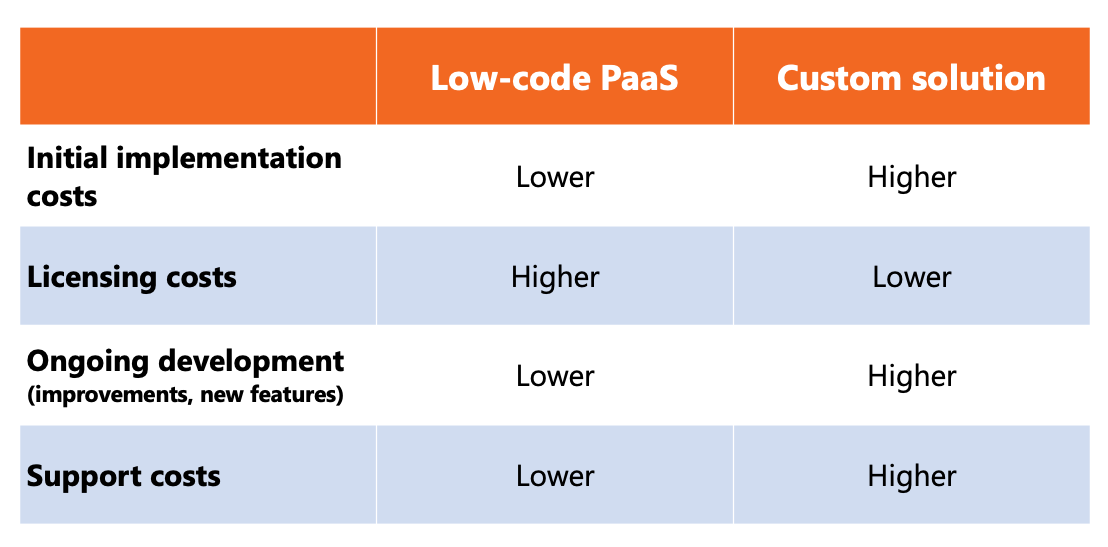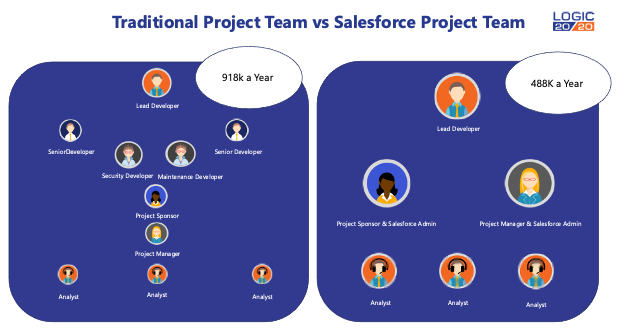5-minute read
Low-code/Salesforce teams can deliver considerable cost savings and shorten development timeframes—if they’re implemented strategically.
Under a traditional IT-business relationship, the business compiles its requirements and submits a request to the IT team, which assigns resources to develop, test, and launch the product. Depending on the size of the organization, the IT resources available, and the nature of the request, the entire process could take months to complete, even in a best-case scenario.
This traditional arrangement has created a supply-demand conundrum: the demand for custom applications is increasing, and the IT resources available to meet the demand are limited. While many businesses are exploring low-code and no-code platforms as a solution to this disconnect, maximizing the ROI of this approach requires a strategic perspective.
Resolving the supply-demand conundrum
Low-code and no-code platforms resolve the disconnect between supply and demand by placing solutions in the hands of administrators, who are able to master the administration (configuration) tools on the platform with less than a month of training (compared to months or years of training for developers). Administrators of platform-as-a-service (PaaS) tools are not systems administrators from the early ‘00s using the command line to reboot and troubleshoot, but business analysts and implementors in their own right, wielding powerful user interfaces featuring drag-and-drop functionality to configure and enable the features they need—no code required.
Administrators provide the human component of a bridge between business users and IT: the configuration route to functionality.
Low-code vs. custom solutions: a cost-benefit analysis
Low-code, configurable solutions might seem like an obvious choice for businesses, but there are several factors that impact the decision to invest in this space. For a basic side-by-side analysis, let’s compare Salesforce, a low-code platform of choice for many companies, with custom development solutions. We’ll assume both are cloud-hosted and keep our comparison at a high level:

Generally (to be fair, very generally!), Salesforce would be faster (and therefore less expensive, depending on the amount of configuration and customization required) to implement and require less outlay for ongoing development and support … but can get expensive in terms of both per-user and per-year fees.
So where do you have the most room to pull a lever and maximize the price: performance ratio of Salesforce on an ongoing basis?
• Initial implementation costs (i.e., the cost to migrate a business line to Salesforce from another platform or set up a business line for the first time) are a one-time cost center.
• Support costs, depending on how you define them, could be viewed as fixed, or at least predictable, based on your operating model (that is, they’re variable based mainly on how highly you prioritize the reduction of technical debt against other, more forward-focused priorities).
• Given its variable cost based on the volume of digital transformation projects in your organization, ongoing development arguably has the most potential to cost your organization money.
Traditional software teams vs Salesforce teams
By placing development ability in the hands of business users, Salesforce and other low-code solution providers enable enterprises to develop custom business applications with leaner teams and at lower cost.
A traditional software team requires multiple developers to plan and execute the development, testing, and deployment of each new application. With Salesforce Platform, Salesforce admins can take on the bulk of the work, supervised by a lead developer and supported by analysts. We did some calculations based on the average salaries of each job title, and the cost difference between traditional teams and Salesforce teams is striking:

Based on the following estimates of average salaries: Software Developer $107,510 (U.S. Bureau of Labor Statistics); Project Manager $94,791 (PayScale); Analyst Salary: $63,820 (Salary.com); Salesforce Admin $77,503 (Glassdoor)
Before making the leap to low-code: 2 considerations
On paper, opting for low-code/Salesforce teams over traditional approaches to development may seem like a no-brainer for businesses seeking lower costs and faster releases. While Salesforce is certainly capable of delivering on both counts, businesses must ensure they understand all the ramifications of the Salesforce platform’s development model, considering such factors as the following.
Firstly, assess how well low-code teams can scale to larger development teams. There are many models for scaling up PaaS teams, each with its own merits. How teams scale—or even, to begin with, divide work amongst themselves—is worth understanding from a functional perspective because it is different from traditional development teams.
Unlike, say, a large custom development project that is microservices-based, where a program might divide the team up into pods based on each microservice, Salesforce projects are less easy to delineate. Parallel projects often overlap spaces and conflicts are easily possible. Further, the complexity of the work and team structure may lend themselves well—or not—to shared success. Logic20/20 has deep experience with large development teams and can help you determine your organization’s specific needs in this area.
Secondly, how teams manage the software development lifecycle (e.g. source control, etc.) differs greatly. Salesforce offers an array of tools, including DX, unlocked packages, change sets, and others. The best way to leverage them is not always obvious. Here again, Logic20/20 offers the expertise to help you select the right tools and implement them in a way that delivers the greatest benefit.
To learn more about Salesforce development teams and how to make them work for your organization, contact us—we’d love to chat with you.
Like what you see?

Alexis Greenwood is a manager in the Logic20/20 Digital Transformation practice, focused on offerings development and innovations. In her experience as a business systems analyst, she enabled change through development of low-code platforms, including Salesforce and ServiceNow, custom applications, virtual assistants, and a variety of tools, including ERPs, ITSM tools, and CRMs.

Ankit Udas is a consultant in the Logic20/20 Strategy & Operations practice. With his project experience with CRM tools and business management platforms, he applies what he has learned as a platform user to enable impactful process changes utilizing low-code tools like Salesforce.

